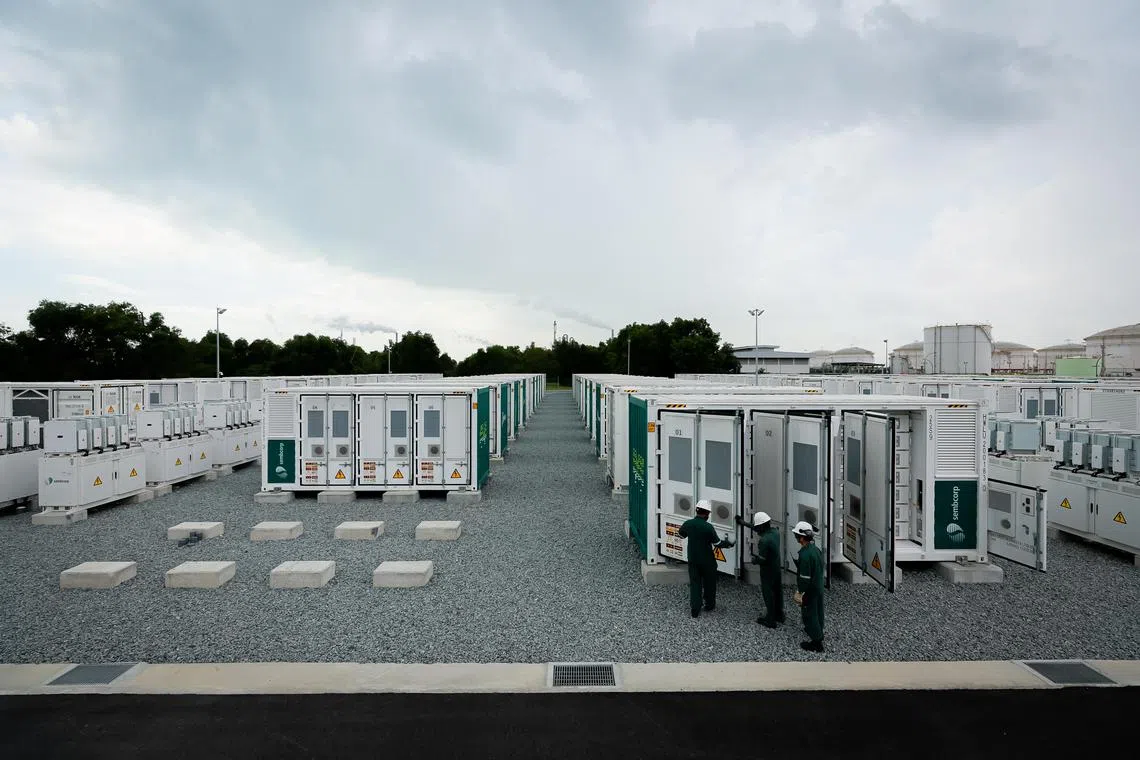Sembcorp first-half profit dips 1%; shares tumble nearly 14%
Sign up now: Get ST's newsletters delivered to your inbox

The Sembcorp Energy Storage System site in Banyan on Jurong Island.
PHOTO: ST FILE
Follow topic:
SINGAPORE – Sembcorp Industries posted a net profit of $536 million for the half-year ended June 30, down 1 per cent from the same period a year ago, on lower gas contributions.
The company also announced an interim dividend of nine cents a share, to be paid out on Aug 26 – up from six cents a year ago.
Revenue for the half-year fell 8 per cent to $2.9 billion from $3.2 billion a year ago.
Sembcorp shares closed at $6.72, down 13.9 per cent or $1.08, on Aug 8.
The earnings decline was mainly due to the lower contributions from gas and related services on weaker pool prices in Singapore, and the absence of contribution from Sembcorp Environment – a waste management subsidiary that was sold.
But this was partially offset by higher gas sales in Singapore, as well as new capacity additions and acquisitions in the renewables segment.
First-half earnings were also weighed down by foreign exchange losses on a deferred payment note (DPN) for Sembcorp’s sale of its coal business in India to an Omani consortium. The deal is denominated in the Indian rupee, which has seen its value slip relative to the Singapore dollar.
Sembcorp booked a $95 million DPN forex loss for the half-year, compared with a $46 million gain for the same period in 2024.
Exceptional items for the first half of 2025 totalled $140 million, comprising $142 million profit from the sale of the waste management subsidiaries in Singapore, offset by a $2 million fair value loss related to a prior acquisition in India.
Earnings per share for the half-year came in at 30.13 cents, compared with 30.47 cents a year ago.
The energy and urban solutions provider chalked up the decline in gas and related service earnings to lower generation spreads in Singapore and the absence of contribution from Phu My 3 in Vietnam, which was offset by contribution from Senoko Energy.
Phu My 3 is a power plant in Vietnam that was transferred to state provider Vietnam Electricity on March 1, 2024.
Meanwhile, the earnings growth in renewables was due to higher contribution from India on better wind resource and increased operational renewables capacity, Sembcorp said.
This offset the drop in business from China – which saw lower tariffs and higher curtailment – where the amount of electricity generated has to be restricted.
Sembcorp’s integrated urban solutions segment posted a stable net profit before exceptional items of $74 million, a slight increase from $73 million a year ago, supported by higher land sales in Indonesia and improved earnings from the water business in China.
Sembcorp group chief executive Wong Kim Yin said the company delivered resilient results for the half-year despite macroeconomic uncertainties.
“The defensiveness of our portfolio will continue to underpin the resilience of our earnings,” he said in a statement.
At the results briefing on Aug 8, Mr Wong said this resilience allowed the interim dividend to be 50 per cent higher than that for the first half of 2024.
He also noted the mixed impact of the stronger Singapore dollar.
On the one hand, the stronger Singapore dollar relative to currencies in Sembcorp’s overseas businesses dragged down the bottom line to the tune of $23 million.
On the other hand, a strong Singapore dollar is favourable for making overseas acquisitions.
When asked to elaborate on potential acquisitions, Mr Wong would say only that the acquisitions would be over $100 million and in areas within Sembcorp’s existing footprint, including the Middle East.
At the results briefing, Mr Wong touched on the significance of Sembcorp’s stake in Senoko Energy, which Sembcorp had increased from 30 per cent to 50 per cent in June.
He said owning a stake in Senoko Energy allows Sembcorp to tap electricity from Senoko Power Station, capping Sembcorp’s exposure to the wholesale electricity market, which enables the company to offer more aggressive contract pricing.
Ms Carmen Lee, head of OCBC Investment Research, told The Straits Times the steep decline in the share price following the results announcement appears to be a “knee-jerk reaction to a significant revenue miss”.
The $2.9 billion result fell short of market expectations of $3.35 billion, she said, citing a Bloomberg consensus poll.
Ms Lee said: “While net profit held steady, the revenue miss likely raised concerns about growth momentum, especially in key segments like renewables and utilities.
“This discrepancy may have triggered a valuation reset, particularly if analysts had priced in stronger top-line performance.”


